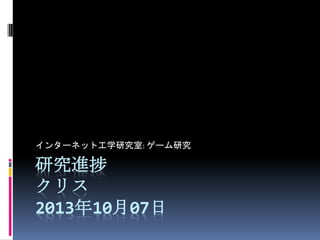Chris lab meeting oct 7th 2013
- 2. í˜Ðò ? ¡°The Art of Videogames¡± (Tavinor 2009) ? Tavinor¡¯s proposed Definition ? Collaboration with Prof. Fujita/GDC 2014 ? Due: Oct 23 (Wed) ? Background: ? Magic Circle ? Embedded vs. Emergent Narrative ? Fujita¡¯s Model: ¡°Phenomenon of Narrative¡± ? GDC Contribution 2
- 3. Art of Video Games (1) ? Defining ¡°videogames¡± ? Current definitions fail to consider all anomalous cases (so-called ¡°Platypus Effect¡±) ? Therefore, Tavinor proposes a disjunctive definition (OR) 3
- 4. Art of Video Games (2) ? Disjunctive Definition ¡°X is art if and only if it has property A or property B 4
- 5. Art of Video Games (3) ? Tavinor¡¯s Disjunctive Definition of videogames: ? "X is a videogame if it is an artifact in a visual digital medium, is intended as an object of entertainment, and is intended to provide such entertainment through the employment of one or both of the following modes of engagement: rule and objective gameplay or interactive fiction.¡± 5
- 6. Art of Video Games (4) Tavinor¡¯s Disjunctive Definition of videogames: Artifact in VDM AND For Entertainment AND Rule/Objective Gameplay OR VIDEOGAME Interactive Fiction 6
- 7. Art of Video Games (5) ? Tavinor¡¯s Disjunctive Definition of videogames: PROS CONS Reconciles the Ludological/ Narratological contentions Newness of the proposal means acceptance of theory is not yet traceable Accounts for most anomalies in gaming media Definition can be seen as too inclusive 7
- 8. Collab. w/ Prof. Fujita (1) ? Background: ¡°The Magic Circle¡± Huizinga (1955); Zimmerman & Salen (2004) ? Border between the virtual game world and the real world ? In modern games, the Magic Circle is very porous. ? Understanding the relationship between the realms on either side of the Magic Circle is central to many aspects of Game Studies/Design 8
- 9. Collab. w/ Prof. Fujita (2) ? Embedded vs. Emergent Narrative Emergent Narrative Magic Circle Embedded Narrative 9
- 10. Collab. w/ Prof. Fujita (3) ? Phenomenon of Narrative 10
- 11. Collab. w/ Prof. Fujita (4) ? Phenomenon of Narrative Don¡¯t go there, there are monsters! OK, Dad, I won¡¯t. I¡¯m TOTALLY going to that cave! 11
- 12. Collab. w/ Prof. Fujita (5) ? Phenomenon of Narrative ? The kid goes to the dangerous place ? Has an adventure, lives to tell the story ? TELLS THEIR FRIENDS AT SCHOOL THE NEXT DAY! 12
- 13. Collab. w/ Prof. Fujita (6) ? Phenomenon of Narrative VIDEO GAME Embedded Narrative Player 13
- 14. Collab. w/ Prof. Fujita (7) ? Phenomenon of Narrative EMERGENT NARRATIVE ? SNS ? ¥Ë¥³¥Ë¥³„Ó» ? Youtube ? Fan Conventions 14
- 15. Collab. w/ Prof. Fujita (8) ? GDC Plan/Contribution ? After this ¡°Phenomenon of Narrative¡± is introduced, Prof. Fujita will explain his prototype game using UX + pop-up photography (his research focus) ? Chris¡¯ portion of the proposal will focus on the main differences in Narrative implementation between Japanese and Western Games ? Frame Narrative ? 4th Wall ? Endo¡¯s ¡°Narrative vs. Story¡± typed games (CEDEC) 15
- 16. ½ñáá¤ÎÕnî} ? GDC 2014 Proposal ? Oct 23rd (Wed) ? Contributions (Recommendations for Industry) ? PAX East 2014 (Boston) ? http://east.paxsite.com/ 16
















